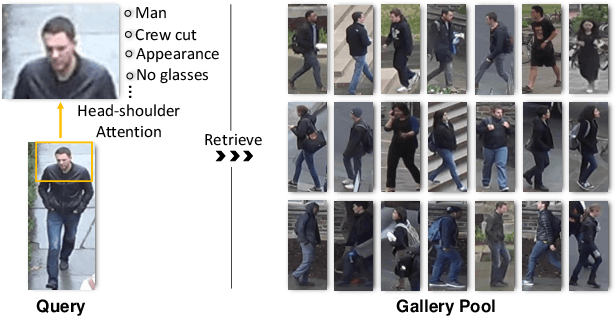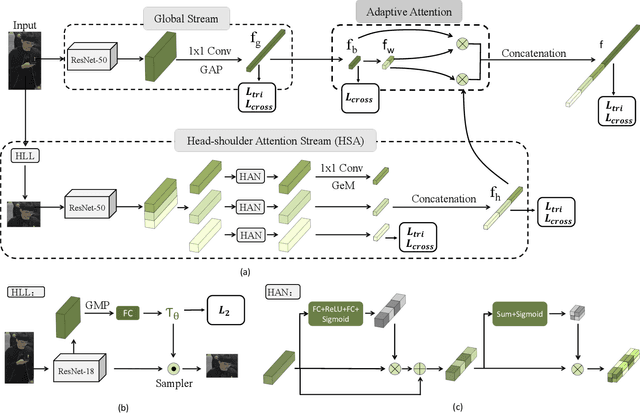Boqiang Xu
Learning Feature Recovery Transformer for Occluded Person Re-identification
Jan 05, 2023



Abstract:One major issue that challenges person re-identification (Re-ID) is the ubiquitous occlusion over the captured persons. There are two main challenges for the occluded person Re-ID problem, i.e., the interference of noise during feature matching and the loss of pedestrian information brought by the occlusions. In this paper, we propose a new approach called Feature Recovery Transformer (FRT) to address the two challenges simultaneously, which mainly consists of visibility graph matching and feature recovery transformer. To reduce the interference of the noise during feature matching, we mainly focus on visible regions that appear in both images and develop a visibility graph to calculate the similarity. In terms of the second challenge, based on the developed graph similarity, for each query image, we propose a recovery transformer that exploits the feature sets of its $k$-nearest neighbors in the gallery to recover the complete features. Extensive experiments across different person Re-ID datasets, including occluded, partial and holistic datasets, demonstrate the effectiveness of FRT. Specifically, FRT significantly outperforms state-of-the-art results by at least 6.2\% Rank-1 accuracy and 7.2\% mAP scores on the challenging Occluded-Duke dataset. The code is available at https://github.com/xbq1994/Feature-Recovery-Transformer.
META: Mimicking Embedding via oThers' Aggregation for Generalizable Person Re-identification
Dec 16, 2021



Abstract:Domain generalizable (DG) person re-identification (ReID) aims to test across unseen domains without access to the target domain data at training time, which is a realistic but challenging problem. In contrast to methods assuming an identical model for different domains, Mixture of Experts (MoE) exploits multiple domain-specific networks for leveraging complementary information between domains, obtaining impressive results. However, prior MoE-based DG ReID methods suffer from a large model size with the increase of the number of source domains, and most of them overlook the exploitation of domain-invariant characteristics. To handle the two issues above, this paper presents a new approach called Mimicking Embedding via oThers' Aggregation (META) for DG ReID. To avoid the large model size, experts in META do not add a branch network for each source domain but share all the parameters except for the batch normalization layers. Besides multiple experts, META leverages Instance Normalization (IN) and introduces it into a global branch to pursue invariant features across domains. Meanwhile, META considers the relevance of an unseen target sample and source domains via normalization statistics and develops an aggregation network to adaptively integrate multiple experts for mimicking unseen target domain. Benefiting from a proposed consistency loss and an episodic training algorithm, we can expect META to mimic embedding for a truly unseen target domain. Extensive experiments verify that META surpasses state-of-the-art DG ReID methods by a large margin.
Black Re-ID: A Head-shoulder Descriptor for the Challenging Problem of Person Re-Identification
Aug 19, 2020



Abstract:Person re-identification (Re-ID) aims at retrieving an input person image from a set of images captured by multiple cameras. Although recent Re-ID methods have made great success, most of them extract features in terms of the attributes of clothing (e.g., color, texture). However, it is common for people to wear black clothes or be captured by surveillance systems in low light illumination, in which cases the attributes of the clothing are severely missing. We call this problem the Black Re-ID problem. To solve this problem, rather than relying on the clothing information, we propose to exploit head-shoulder features to assist person Re-ID. The head-shoulder adaptive attention network (HAA) is proposed to learn the head-shoulder feature and an innovative ensemble method is designed to enhance the generalization of our model. Given the input person image, the ensemble method would focus on the head-shoulder feature by assigning a larger weight if the individual insides the image is in black clothing. Due to the lack of a suitable benchmark dataset for studying the Black Re-ID problem, we also contribute the first Black-reID dataset, which contains 1274 identities in training set. Extensive evaluations on the Black-reID, Market1501 and DukeMTMC-reID datasets show that our model achieves the best result compared with the state-of-the-art Re-ID methods on both Black and conventional Re-ID problems. Furthermore, our method is also proved to be effective in dealing with person Re-ID in similar clothing. Our code and dataset are avaliable on https://github.com/xbq1994/.
 Add to Chrome
Add to Chrome Add to Firefox
Add to Firefox Add to Edge
Add to Edge